
Galls or cecidia are a kind of swelling growth on the external tissues of plants, fungi, or animals. Plant galls are abnormal outgrowths of plant tissues, similar to benign tumors or warts in animals. They can be caused by various parasites, from viruses, fungi and bacteria, to other plants, insects and mites. Plant galls are often highly organized structures so that the cause of the gall can often be determined without the actual agent being identified. This applies particularly to some insect and mite plant galls. The study of plant galls is known as cecidology.

Alnus glutinosa, the common alder, black alder, European alder, European black alder, or just alder, is a species of tree in the family Betulaceae, native to most of Europe, southwest Asia and northern Africa. It thrives in wet locations where its association with the bacterium Frankia alni enables it to grow in poor quality soils. It is a medium-sized, short-lived tree growing to a height of up to 30 metres (100 ft). It has short-stalked rounded leaves and separate male and female flowers in the form of catkins. The small, rounded fruits are cone-like and the seeds are dispersed by wind and water.

A domatium is a tiny chamber produced by plants that houses arthropods.

Andricus foecundatrix is a parthenogenetic gall wasp which lays a single egg within a leaf bud, using its ovipositor, to produce a gall known as an oak artichoke gall, oak hop gall, larch-cone gall or hop strobile The gall develops as a chemically induced distortion of leaf axillary or terminal buds on pedunculate oak or sessile oak trees. The larva lives inside a smaller hard casing inside the artichoke and this is released in autumn. The asexual wasp emerges in spring and lays her eggs in the oak catkins. These develop into small oval galls which produce the sexual generation of wasps. A yew artichoke gall caused by the fly Taxomyia taxi also exists, but is unrelated to the oak-borne species. Previous names or synonyms for the species A. fecundator are A. fecundatrix, A. pilosus, A. foecundatrix, A. gemmarum, A. gemmae, A. gemmaequercus, A. gemmaecinaraeformis and A. quercusgemmae.
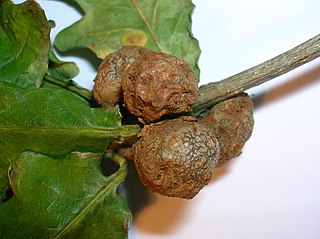
Cola-nut galls develop as a chemically induced distortion of leaf axillary or terminal buds on pedunculate oak or sessile oak trees, caused by the agamic gall wasp Andricus lignicola which lays single eggs within leaf buds using their ovipositor. A previous name or synonym for the species A. lignicola is A. lignicolus and A. venheurni.
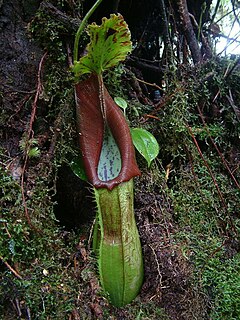
Nepenthes naga is a tropical pitcher plant endemic to the Barisan Mountains of Sumatra. It is characterised by a forked sub-apical appendage on the underside of the lid and an undulate lid margin. The specific epithet naga is the Indonesian word for "dragon" and refers to the distinctive lid appendage of this species as well as the large size of its pitchers. The name also references local folklore, which tells of dragons occurring in this species's habitat in the past.

Rabdophaga rosaria is a gall midge which forms Camellia galls or terminal rosette gall on willow species. It was first described by Hermann Loew in 1850.

Eriophyes tiliae is a mite that forms the lime nail gall or bugle gall. It develops in a chemically induced gall; an erect, oblique or curved distortion rising up from the upper surface of the leaves of the common lime (linden) tree Tilia × europaea.
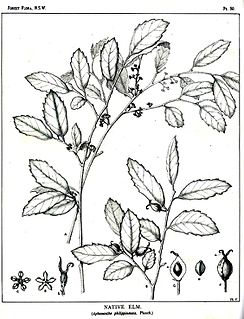
Aphananthe philippinensis is a common rainforest tree in the family Cannabaceae. In Australia it occurs from the Manning River in New South Wales to near Herberton in tropical Queensland. It was first described from the island of Luzon in the Philippines, hence the species name. The generic name of Aphananthe refers to insignificant flowers. This plant also occurs on the Solomon Islands and in Papua New Guinea

Neuroterus albipes is a gall wasp that forms chemically induced leaf galls on oak trees which has both bisexual and agamic generations and therefore forms two distinct galls, the smooth spangle gall and Schenck's gall. Neuroterus laeviusculus and Spathegaster albipes are previous binomials found in the literature.
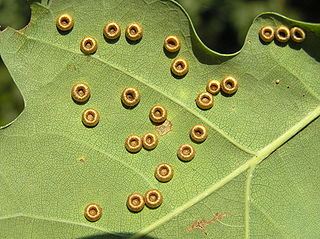
Neuroterus numismalis is a gall wasp that forms chemically induced leaf galls on oak trees. It has both bisexual and agamic (parthenogenetic) generations and forms two distinct galls on oak leaves, the silk button gall and blister gall. The galls can be very numerous with more than a thousand per leaf.
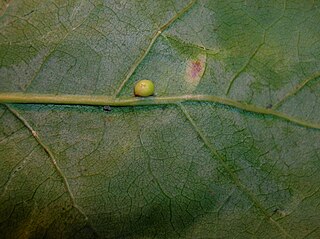
Neuroterus anthracinus is a widely distributed gall wasp that forms chemically induced leaf galls on oak trees. N. anthracinus has both sexual and agamic generations and in consequence forms two distinct galls, the oyster gall and April-bud gall.

Eriophyes is a genus of acari that forms galls, specially on trees of the family Rosaceae. Some are called blister mites. The blue butterfly Celastrina serotina has been reported to feed on these galls and also on the mites, making it one of the uncommon carnivorous Lepidoptera.
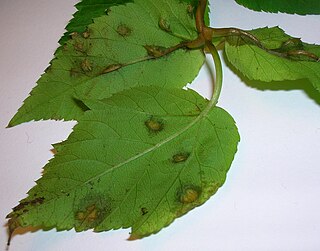
Protomyces macrosporus is an ascomycete fungus that forms galls on Aegopodium podagraria, Anthriscus sylvestris, Angelica sylvestris, Daucus carota and some other members of the family Umbelliferae or Apiaceae, commonly known as umbellifers. Fourteen genera within the Asteraceae are also galled by P. macrosporus. The description of the genus was based on Protomyces macrosporus as the type genus for the family Protomycetaceae.

Phytoptus avellanae is an acarine gall-mite species inducing big bud galls of up to 10 millimetres (0.39 in) across, sometimes slightly open, on the buds of hazel and on filbert. Synonyms include Phytocoptella avellanae, Eriophyes avellanae, Calycophthora avellanae, Phytoptus coryli, Phytoptus pseudogallarum, and Acarus pseudogallarum. The mites are white, about 0.3 mm long, with numerous tergites and sternites. Two forms of P. avellanae exist, a gall causer and a vagrant form that has a more complex life-cycle and does not form galls.

Phyllocoptes eupadi is a mite that chemically induces a pouch gall to develop as a sub-spherical distortion rising up from the upper surface of the lamina of leaves of blackthorn shrubs Prunus spinosa and other Prunus spp. Synonyms are Eriophyes padi (Nalepa) and Phytoptus padi prunianus.
Eriophyes tulipae, commonly known as the dry bulb mite, is a species of mite in the genus Eriophyes. This mite feeds on members of the lily family, and has damaged garlic crops. At one time, it was also thought to feed on wheat and other grasses, but the wheat curl mite is now regarded as a different species, Aceria tosichella.

Eriocampa ovata, known generally as the alder sawfly or woolly alder sawfly, is a species of common sawfly in the family Tenthredinidae. The larvae feed on the leaves of the common alder and the grey alder, sometimes causing defoliation.

Acalitus brevitarsus is an eriophyid mite which induces domed, blister like swellings, known as galls, on some species of alder.

Eriophyes laevis is a gall mite which makes small, pimple-like galls on the leaves of alder. The mite was first described by the Austrian zoologist, Alfred Nalepa in 1889 and is found in Europe and North America.



















